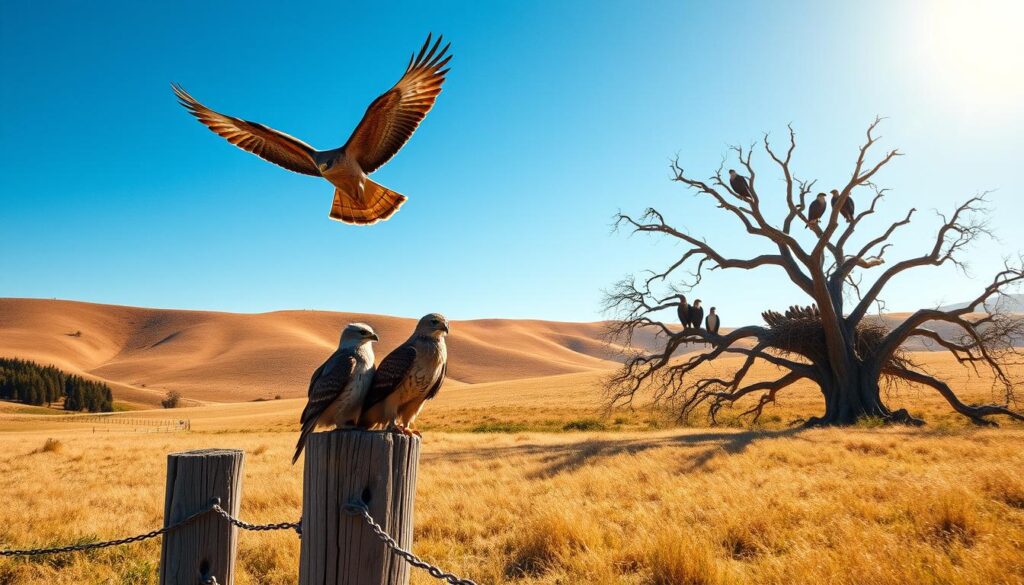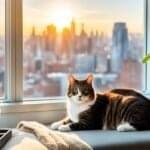California Birds of Prey: California is full of wonders for those who love birds and nature. It has a wide range of birds of prey that fly beautifully across different areas. From the coast to deep forests, the state has amazing raptors. Each kind has special skills that help them live in their own places. My journey into their world shows their beauty and how important they are for nature’s balance.
In this article, we’ll look closely at the many kinds of birds of prey in California, like the Red-tailed Hawk and the Golden Eagle. We’ll learn about where they live and how they act. I’ll also give tips for watching these amazing birds in California. This will help you understand and love these amazing animals more. Let’s go on a journey in the skies of California, seeing how its raptors help our environment.
Key Takeaways
- California hosts a remarkable variety of birds of prey, including the iconic Bald Eagle and Golden Eagle.
- The Klamath Basin is the largest winter gathering site for Bald Eagles in the continental United States.
- Birdwatching in California peaks during the winter months, particularly for observing Bald Eagles.
- Over 30 species of raptors, including the adaptable Red-tailed Hawk, call California home.
- Efforts to conserve and protect these majestic raptors are ongoing and vital for their continued existence.
Introduction to California’s Birds of Prey
California is rich in birds of prey, or raptors. These beautiful birds are key to keeping balance in nature. They help us understand why saving them and their habitat is crucial.
What Are Birds of Prey?
Birds of prey are predators with great hunting abilities, sharp vision, and hooked beaks. They eat other animals, making them important in the food chain. California is home to over 30 species like eagles, falcons, and owls. Each has special skills for survival.
Importance in the Ecosystem
Raptors play a big role in their homes. They keep rodent populations in check, preventing too many from overtaking the area. Being top hunters, they keep the animal world balanced. We must protect them for their sake and the health of California’s ecosystems.
The Most Common Raptors in California
California is home to many fascinating raptors, known as birds of prey. They live in different environments, showing great adaptability and skill in hunting. The variety among these birds is impressive, especially in the most common species.
Red-tailed Hawk
The Red-tailed Hawk is the hawk you’ll see most often in California. It measures from 45 cm to 60 cm in length and has a wingspan of 105 cm to 141 cm. This large bird is easy to spot because of its broad wings and unique call. It is commonly found in open fields and deserts, gliding high above, looking for small mammals to eat.
Cooper’s Hawk
The Cooper’s Hawk is another widespread raptor in California. It ranges from 35 cm to 50 cm in length, with a wingspan between 62 cm and 99 cm. This bird is great at living in suburban areas and hunts smaller birds, like pigeons and doves. You can often see Cooper’s Hawks sitting on telephone wires or in trees, moving through their habitat with incredible speed and agility. They are expert hunters among California’s birds of prey.
American Kestrel
The American Kestrel is North America’s smallest falcon, easily spotted in California’s open spaces. It measures about 22 cm to 30 cm long, with a wingspan of 50 cm to 61 cm. Known for its unique hunting style, the American Kestrel catches insects and small birds at speeds of 25 to 45 miles per hour. Its presence adds to the rich variety of common raptors in California, helping maintain the ecosystem’s balance.
Unique Traits of California Raptors
California raptors have amazing features that help them hunt. They have adapted to be top predators in their environment. Knowing about these traits helps us understand their hunting abilities and what makes them special.
Exceptional Vision
One key trait of these birds is their incredible vision. Their large eyes and special muscles let them see movement from far away. This sharp eyesight helps them quickly focus on prey, both near and distant.
Sharp Talons and Beaks
Their talons and beaks are vital for their hunting. The talons are strong for grabbing prey. Their beaks are designed to tear into flesh, showing how their bodies are built for hunting.
Hunting Techniques
California raptors use different hunting methods, based on their role in nature. Some soar high to look for prey below. Others, like the Peregrine Falcon, dive fast to catch their target. These techniques demonstrate their unique adaptations, helping them survive in various habitats.
The Habitat of California Birds of Prey
California offers a mix of habitats, perfect for different raptor species. From coastal areas and thick woods to vast deserts, each setting supports various birds of prey. They find what they need to live, hunt, and raise their young in these environments.
Coastal Regions
California’s coasts are a paradise for birds like Ospreys and Bald Eagles. The waters near the shore are full of fish, making great hunting spots. Plus, tall trees and cliffs along the coast offer perfect nests for these birds.
Forests and Woodlands
Great Horned Owls and Cooper’s Hawks call the dense forests home. They need the trees for nesting and hunting small animals and birds. These forests are full of life, providing plenty of food for the raptors.
Desert Areas
In California’s deserts, birds like the American Kestrel show their ability to adapt. Despite the tough conditions, they manage to find food over large open spaces. It’s fascinating to see how well they do in such environments, which is vital for their protection.
| Habitat | Key Raptors | Main Features |
|---|---|---|
| Coastal Regions | Osprey, Bald Eagle | Abundant fish supply, cliffs for nesting |
| Forests and Woodlands | Great Horned Owl, Cooper’s Hawk | Densely wooded areas for nesting, diverse prey |
| Desert Areas | American Kestrel | Open terrain for spotting prey, harsh conditions |
Bird Watching Guidelines
Starting a bird watching journey gives a chance to see California’s amazing raptors. It’s important to know when and where to find these majestic birds. Knowing the best times and places makes bird watching in California a success.
Best Times for Observation
The best times to see raptors are early mornings and late afternoons. This is when many species are out hunting, especially in winter. Watching at these times often leads to seeing various raptors, making the experience more fulfilling.
Recommended Viewing Locations
Finding the best places for seeing raptors is key. Here are top spots in California for bird watching:
- San Francisco Bay Area: This area has different habitats, attracting many raptor types.
- Klamath Basin: It’s a major migration path, providing lots of chances to see various raptors.
- Sacramento Valley: Known for its biodiversity and regular raptor sightings.
| Location | Best Time to Visit | Most Common Raptors |
|---|---|---|
| San Francisco Bay Area | Early morning, late afternoon | Red-tailed Hawk, American Kestrel |
| Klamath Basin | Winter months | Bald Eagle, Golden Eagle |
| Sacramento Valley | Year-round | Cooper’s Hawk, Northern Harrier |
Conservation Efforts for Raptors

Protecting raptors in California means knowing the risks they face and supporting conservation. The threats to birds of prey are many, and certain species are declining fast. Urban development, pesticides, and climate change threaten their survival. These issues don’t just harm raptors but whole ecosystems too.
Threats Facing Birds of Prey
Raptors face many dangers that make survival tough. The main problems are:
- Loss of natural habitats due to development and agriculture.
- Pesticide exposure that can lead to reproductive issues and death.
- Climate change altering migratory patterns and nesting sites.
- Human disturbance in critical breeding areas.
- Collisions with man-made structures such as wind turbines and power lines.
Since August 1994, the U.S. Fish and Wildlife Service listed 18 raptor species as endangered or threatened. Saving California’s raptors means tackling these threats head-on.
Local Organizations and Initiatives
Many groups are working hard to help raptors. The California Department of Fish and Wildlife is key in raptor protection initiatives. They focus on fixing habitats, making new laws, and teaching people. Other important groups include:
| Organization | Focus Area | Conservation Actions |
|---|---|---|
| The Peregrine Fund | Global Raptor Conservation | Restoration and monitoring of raptor populations |
| Global Raptor Impact Network (GRIN) | Data Collection & Analysis | Comprehensive database for monitoring raptor species |
| San Diego Wild Animal Park | California Condor Recovery | Captive breeding and education programs |
These groups take important steps that show how much we all need to help. By focusing on California raptors, we make sure these amazing birds are safe.
Raptors in Urban Settings
The presence of raptors in cities shows how well they adapt to urban life. A study found over 600 raptor nests near busy areas. Red-tailed Hawks and Cooper’s Hawks have made cities their home. They use buildings to nest and find food.
Adaptation to City Life
Raptors are adjusting to life in cities. They use tall buildings for nesting and to look for food. Cooper’s Hawks hunt city animals like pigeons and rodents. A study noted that raptors who eat a variety of foods are more common in cities. Raptors that usually live in woods do well in urban areas too.
Benefits of Urban Birds of Prey
Birds of prey are good for cities not just because they are beautiful. They help control pests and add to city biodiversity. They allow people to see wildlife up close. This helps city folks get involved in protecting these birds. Workshops teach about caring for trees that house birds, bringing people closer to nature.
Seasonal Behavior of California Birds of Prey
The raptors in California have special migration and breeding patterns. Food and homes in their environment affect these patterns. Learning about these helps us understand and protect these amazing birds.
Migration Patterns
California raptors migrate in an impressive way. Hawks and eagles travel far to find the right places to live. From August to December, Turkey vultures move south in big groups, sometimes almost 100 birds at the Golden Gate.
In spring, they head back from late February to May. Early birds like Red-tailed Hawks show up in September from nearby nests. Yet, late movers in November may come from as far as Canada, showing different nesting spots lead to different winter homes.
Breeding Seasons
Raptors in California breed at various times, depending on the species. In the Bay Area, Red-tailed Hawks start nesting in mid-February and lay eggs from early to late March. Red-shouldered Hawks have a breeding time from late February to May. Cooper’s Hawks set up nests and lay eggs a bit later, from late March to May.
Some, like Great Horned Owls, nest as soon as December. White-tailed Kites are unique because they can nest several times a year, reacting to changes in the environment like mouse numbers. Generally, in the Bay Area, raptors nest from February to August. This shows why managing their homes is key for their protection during these months.
| Species | Nesting Start | Nesting End | Migration Behavior |
|---|---|---|---|
| Red-tailed Hawk | Mid-February | Late March | Local nesting; minimal migration |
| Red-shouldered Hawk | Late February | May | Resident, nests in territory |
| Cooper’s Hawk | Late March | May | Resident, some local migration |
| Great Horned Owl | December | March | Resident, minimal migration |
| White-tailed Kite | Mid-February | October | Nests multiple times; responsive to prey |
Fun Facts About California Raptors
California’s raptors have unique features that excite bird lovers and experts. They have incredible flight skills and live for a long time. These traits make them fascinating birds of prey.
Incredible Flight Speeds
The Peregrine Falcon is the world’s fastest bird. It can dive at speeds over 200 mph to catch prey. Its hunting skills make it a strong predator. The Amur falcon travels over 22,000 kilometers, showing amazing endurance and navigation.
Lifespan of Common Raptors
Different raptors live for varying lengths of time. For example, the Red-tailed Hawk lives about 10 to 15 years in the wild. Larger eagles can live over 20 years, depending on their environment and survival skills. These raptors face many challenges in their natural homes.
| Species | Typical Lifespan (Years) | Flight Speed (mph) |
|---|---|---|
| Peregrine Falcon | 6-10 | Over 200 (during dive) |
| Red-tailed Hawk | 10-15 | Up to 120 (level flight) |
| Bald Eagle | 20-30 | Up to 30 (level flight) |
| California Condor | 60 | Up to 55 (level flight) |
Conclusion: Preserving California’s Raptors
Thinking about the obstacles California’s birds of prey face, we all have a key role in saving them. By getting smarter about these amazing raptors, we can point out the dangers they face. It’s shocking that 880 to 1,330 raptors die each year at Altamont wind sites. This fact shows why it’s so important for communities to help protect raptors.
Our Role in Conservation
It’s our duty to protect these amazing birds. Teaching others about the dangers raptors face helps us all act together. For instance, the Swainson’s Hawk population dropped by 90% in the last 80 years. This shows we must work together to save them.
How to Get Involved
Getting involved is simpler than you might think. By joining conservation groups or taking part in citizen science, you can really help California’s raptors. Working on habitat restoration is key. Also, watching birds responsibly and reporting what you see helps keep track of raptor numbers. By bringing our efforts together, we can make sure these splendid birds thrive for future generations.
FAQ
What are the most common birds of prey found in California?
How do raptors contribute to the ecosystem?
What are the best locations for bird watching in California?
When is the best time to observe raptors in the wild?
What threats do California raptors face?
How have raptors adapted to urban environments?
What are some local organizations working for raptor conservation?
Do raptors migrate, and if so, which ones?
What unique adaptations do California raptors have?
How can I get involved in raptor conservation?
References
| Source Name | URL |
| International Association for Falconry and Conservation of Birds of Prey (IAF) | https://conservationportal.sycl.net/1/falconry-and-conservation |
| Raptor Research Foundation (RRF) | https://raptorresearchfoundation.org/about/ |
| Bird of Prey – Wikipedia | https://en.wikipedia.org/wiki/Bird_of_prey |
| Hawk Mountain Sanctuary | https://www.hawkmountain.org/about/community/our-global-partners |
| Bird of Prey Project | https://birdofpreyproject.org/about-us/ |







